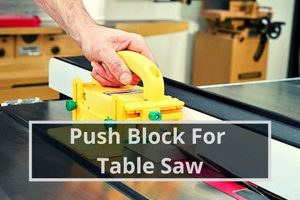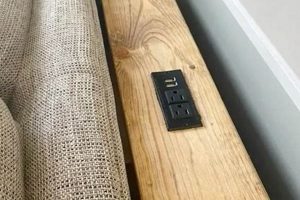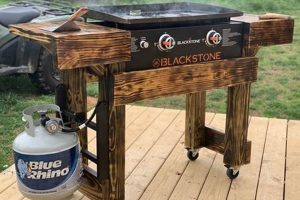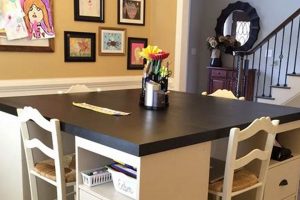A self-constructed sensory station is a contained area designed to provide tactile, visual, auditory, and sometimes olfactory or gustatory stimulation. Commonly used in early childhood education, these stations feature a variety of materials, such as water, sand, rice, or beans, and can be adapted to various themes and learning objectives. For example, a container filled with water and toy boats provides an engaging experience for young children to explore concepts of buoyancy and water displacement.
These constructions offer numerous developmental benefits, including enhanced fine motor skills, sensory exploration, and cognitive development. The hands-on nature of these stations encourages children to explore different textures and materials, fostering creativity and problem-solving skills. Historically, educators have recognized the importance of sensory experiences in learning, and these stations represent a practical and adaptable method for incorporating sensory play into educational environments. They support a multisensory approach to learning, catering to diverse learning styles and promoting deeper engagement with subject matter.
The subsequent discussion will address the various types of these stations, construction techniques, material selection criteria, and relevant safety considerations for effective and responsible implementation. Further exploration will encompass specific examples, age-appropriate adaptations, and methods for integrating these stations into existing curricula, promoting a holistic and enriching learning experience.
Construction Advice for Sensory Engagement Stations
The creation of a stimulating sensory engagement station requires careful planning and execution. Considerations should include the developmental needs of the intended users, material safety, and ease of maintenance. The following recommendations outline key aspects for successful station design and implementation.
Tip 1: Select Appropriate Container Dimensions: The containers size must accommodate the intended materials and allow sufficient space for interaction. Shallow, wide containers are often preferable for younger children to prevent accidental submersion, while deeper containers may be suitable for older children and specific activities involving volume and displacement.
Tip 2: Prioritize Material Safety and Non-Toxicity: All materials used in the station, including the container itself and any accompanying materials, must be non-toxic and free of small parts that could pose a choking hazard. Regularly inspect materials for wear and tear, replacing them as necessary to maintain a safe environment.
Tip 3: Incorporate Thematic Elements to Enhance Engagement: Themed stations, such as an ocean-themed water table with marine animals or a construction-themed sand table with toy trucks, can increase engagement and align with curriculum objectives. Thematic elements should be age-appropriate and designed to encourage imaginative play.
Tip 4: Offer a Variety of Textures and Materials: Include a diverse range of materials with different textures, such as smooth stones, rough fabrics, soft foam, and dry grains. This variety will stimulate tactile exploration and enhance sensory development.
Tip 5: Establish Clear Boundaries and Expectations: Clearly define the area for sensory play and establish rules for usage. This will help to contain materials, minimize mess, and promote responsible interaction with the station.
Tip 6: Consider Mobility and Storage: Incorporate wheels or casters for easy relocation and storage. When not in use, the station should be stored in a clean, dry area to prevent contamination and prolong its lifespan.
Tip 7: Facilitate Easy Cleanup and Maintenance: Choose materials and designs that are easy to clean and maintain. Regularly disinfect the container and materials to prevent the spread of germs. Provide designated areas for wiping hands and cleaning spills.
Implementing these guidelines can contribute to the development of a valuable resource that promotes sensory exploration, cognitive development, and creative expression. The careful selection of materials, adherence to safety protocols, and thoughtful design considerations are essential for maximizing the benefits of this interactive learning tool.
The subsequent discussion will delve into specific material recommendations, age-appropriate activities, and strategies for integrating the sensory station into broader educational contexts.
1. Tactile Material Variety
Tactile material variety is a cornerstone of effective sensory stations. The range of materials directly influences the sensory experience, cognitive stimulation, and developmental benefits derived from interacting with the structure. Diversification encourages exploration, caters to individual preferences, and promotes adaptive responses to novel stimuli.
- Texture Differentiation
Varying textures, from smooth stones to rough fabrics, elicits distinct sensory input. This contrast enhances tactile discrimination skills and stimulates the neural pathways responsible for processing tactile information. In a homemade station, introducing materials like polished river rocks alongside corrugated cardboard provides a diverse tactile experience.
- Material Properties and Learning
Different materials exhibit diverse properties, such as weight, density, and elasticity, that contribute to learning about physics and material science. Water offers opportunities to explore buoyancy and displacement, while sand allows for experimentation with volume and shape manipulation. Incorporating materials with distinct properties into a self-assembled construction facilitates hands-on learning experiences.
- Sensory Adaptation and Engagement
Offering a variety of materials mitigates sensory adaptation, where prolonged exposure to a single stimulus reduces responsiveness. Novel textures and materials maintain user engagement and encourage continued exploration. Rotating materials periodically ensures that the sensory station remains stimulating and conducive to learning.
- Integration with Thematic Activities
Tactile material variety can be strategically integrated with thematic activities to reinforce learning objectives. A nature-themed station might include materials like leaves, twigs, and soil, promoting exploration of natural elements and ecological concepts. Customizing the material selection to align with specific themes enhances the educational value of the station.
The mindful incorporation of tactile material variety is crucial for maximizing the benefits of a sensory station. The diverse range of textures and material properties cultivates tactile exploration, cognitive development, and engagement, transforming the construction into a powerful learning tool.
2. Container Dimensions
Container dimensions are a critical design parameter for any self-constructed sensory learning station. The size and shape of the container directly impact accessibility, safety, and the nature of the sensory experiences offered. Insufficient volume restricts the quantity of materials available for exploration, limiting tactile and visual stimulation. Conversely, excessively large containers pose challenges for young children, potentially leading to accidental submersion or difficulty reaching materials at the center. A shallow, wide container, for example, might be appropriate for toddler-aged children exploring water play, while a deeper, more compact container may suit older children engaged in structured activities involving layering or excavation.
The dimensions also influence the range of activities that can be accommodated. A larger container supports collaborative play, allowing multiple children to interact simultaneously. Smaller containers facilitate individual exploration and focused experimentation. The material selection must be considered alongside the container size. Fine materials, such as sand or rice, require containers with secure seals to prevent leakage. Bulky materials, such as oversized blocks or large quantities of water, necessitate robust containers with reinforced structures to withstand the weight and pressure. Ergonomic considerations are also paramount; the height of the container relative to the user promotes comfortable and prolonged engagement.
In conclusion, the selection of appropriate container dimensions is integral to the successful design and implementation of a homemade station. The dimensions impact safety, accessibility, activity scope, and material compatibility. Precise consideration of these factors ensures the station provides an enriching and developmentally appropriate sensory experience, while mitigating potential hazards and maximizing usability. Neglecting this aspect can compromise the station’s effectiveness and potentially pose risks to the user.
3. Safety Compliance
Safety compliance is a paramount consideration in the construction and utilization of any do-it-yourself sensory station, especially those intended for use by children. Due diligence in material selection, construction techniques, and usage guidelines is essential to mitigate potential hazards and ensure the well-being of users. Neglecting safety protocols can lead to injuries, exposure to harmful substances, or other adverse outcomes.
- Material Toxicity
The selection of non-toxic materials is a fundamental aspect of safety compliance. Paints, adhesives, and fillers utilized in the construction must be certified as non-toxic, particularly if the station is intended for use by young children who may mouth or ingest components. Materials such as lead-based paints or adhesives containing volatile organic compounds (VOCs) pose significant health risks and should be strictly avoided. Prior verification of material safety data sheets (MSDS) is essential to confirm compliance with relevant safety standards.
- Structural Integrity
The structural integrity of the sensory station is critical to prevent collapses or failures that could cause injuries. All joints, connections, and load-bearing components must be securely fastened and capable of withstanding the anticipated weight and stress. Regular inspections for signs of wear and tear are necessary to identify and address potential structural weaknesses before they lead to accidents. The design should avoid sharp edges, protruding hardware, or other potential hazards that could cause cuts or abrasions.
- Choking Hazards
Materials used within the sensory station itself must be evaluated for potential choking hazards, particularly for stations intended for use by infants or toddlers. Small parts, such as beads, buttons, or pebbles, should be avoided or used under strict supervision to prevent accidental ingestion. Mesh bags or containers with small holes should be used with caution, as they can pose entanglement risks. Regularly inspect the station for loose parts or broken components that could become choking hazards.
- Hygiene and Sanitation
Maintaining hygiene and sanitation is essential to prevent the spread of germs and bacteria, particularly in stations that involve water, sand, or other materials that can harbor microorganisms. Regular cleaning and disinfection of the station and its contents are necessary to minimize the risk of infection. Water should be changed frequently, and sand or other granular materials should be periodically replaced. Encourage handwashing before and after use to promote good hygiene practices.
Adherence to these safety compliance principles is not merely a suggestion but an ethical imperative in the context of these homemade sensory stations. By prioritizing material safety, structural integrity, choking hazard prevention, and hygiene, builders can create an enriching and developmentally beneficial environment that minimizes risk and promotes the well-being of users.
4. Cleanup Efficiency
Cleanup efficiency, in the context of a constructed sensory learning station, refers to the ease and speed with which the station and its surrounding area can be restored to a clean and orderly condition after use. This factor directly impacts the practicality, longevity, and overall value of the station, particularly in environments where time and resources are limited.
- Material Selection and Containment
The choice of materials used within the station and the effectiveness of its containment mechanisms significantly influence cleanup demands. Materials that are easily swept, vacuumed, or wiped clean, such as large plastic beads or smooth stones, minimize post-activity cleaning time. Containers with high sides and tight-fitting lids prevent spillage and material dispersion, reducing the area requiring cleanup. A deliberate selection of low-mess materials and effective containment strategies substantially contribute to cleanup efficiency.
- Surface Treatment and Waterproofing
The surfaces of the sensory station itself, and any surrounding flooring or furniture, should be treated with waterproof or stain-resistant coatings. This minimizes the absorption of liquids or other materials, facilitating easy wipe-down and preventing permanent damage. Untreated wood or porous surfaces, conversely, are more susceptible to staining and require more extensive cleaning efforts. Adequate surface preparation and sealing significantly enhance cleanup efficiency and extend the lifespan of the station.
- Design for Accessibility and Removal
The station design should incorporate features that promote easy access for cleaning tools and facilitate the removal of materials. A removable basin or tray allows for quick disposal of used materials, while a simple, uncluttered design minimizes nooks and crannies where debris can accumulate. The ability to easily disassemble components for thorough cleaning further enhances cleanup efficiency. Design considerations that prioritize accessibility and removability contribute significantly to streamlining the post-activity cleaning process.
- Establishment of Cleaning Protocols
The establishment and consistent enforcement of clear cleaning protocols are essential for maintaining cleanup efficiency. Clear guidelines regarding material disposal, surface cleaning, and equipment storage promote consistency and accountability. Designating specific cleaning tools and supplies for use with the sensory station ensures they are readily available and properly maintained. Regular cleaning schedules, coupled with clearly defined protocols, optimize cleanup efficiency and prevent the accumulation of dirt and debris.
These elements, interwoven into the design and management of a self-built sensory exploration area, reduce cleaning time, maintenance effort, and improve its long-term utility. Ignoring the role of cleaning efficiency increases the overall effort needed to run and maintain the sensory station, affecting how often it can be used.
5. Thematic Integration
Thematic integration, when applied to a self-constructed sensory table, augments the developmental benefits and educational impact of the station. By aligning the sensory materials and activities with a specific theme, educators and caregivers can foster deeper engagement, contextualize learning experiences, and stimulate imaginative play.
- Curriculum Alignment
Thematic integration allows for direct alignment with existing curricula. A station designed around oceanography, for example, can incorporate water, sand, shells, and toy sea creatures, complementing lessons on marine life and ecosystems. This contextual reinforcement enhances comprehension and retention of subject matter. Furthermore, thematic stations can be tailored to support interdisciplinary learning, bridging connections between science, language arts, and social studies.
- Enhanced Engagement and Motivation
The implementation of themes naturally increases the engagement level for participants. A dinosaur-themed sensory area may have small dinosaur models, sand, and other excavation tools to simulate the experience of an archaeologist discovering dinosaur bones. This narrative aspect can capture and hold a child’s attention for longer periods compared to a generic, un-themed station. By tapping into children’s interests, thematic integration fosters a sense of curiosity and intrinsic motivation to explore and learn.
- Cognitive Development and Language Enrichment
Thematic integration fosters cognitive development by encouraging children to make connections between sensory experiences and abstract concepts. When interacting with a farm-themed station, children may associate different textures and materials with specific animals or agricultural practices. This process enhances categorization skills, problem-solving abilities, and symbolic thinking. It also provides opportunities for language enrichment, as children describe their sensory experiences and narrate their play scenarios. The integration of thematic vocabulary further expands their linguistic repertoire and strengthens their communication skills.
- Imaginative Play and Social Interaction
The thematic approach encourages imaginative play and supports social interaction. A construction-themed area may inspire creative construction games, problem-solving situations, and teamwork exercises among participants. Integration stimulates the development of narrative skills, role-playing abilities, and cooperative behaviors. This creates an environment that fosters collaboration, communication, and social-emotional development.
In summary, thematic integration transforms a sensory table from a mere collection of materials into a targeted, engaging, and educational resource. Through careful selection of materials and activities that align with specific themes, caregivers and educators can maximize the developmental benefits of the station, foster a love of learning, and promote the holistic growth of the children.
6. Accessibility Height
Accessibility height is a pivotal design factor in a constructed sensory station, dictating the ease with which individuals can interact with the contained materials. This dimension directly impacts the user’s physical comfort, range of motion, and overall engagement with the sensory experience. A height that is too low necessitates excessive bending or crouching, leading to discomfort and fatigue. Conversely, a height that is too high may restrict access for smaller users, limiting their ability to reach and manipulate the sensory materials effectively. In either scenario, compromised accessibility diminishes the intended benefits of the sensory table, potentially discouraging participation and hindering sensory exploration.
The appropriate height for a homemade sensory station varies depending on the age and physical abilities of the intended users. For young children, a lower height, typically ranging from 16 to 20 inches, facilitates comfortable reach and interaction while seated or kneeling. For older children and adults, a higher height, between 24 and 30 inches, may be more suitable, allowing for interaction while standing or using a supportive chair. Adjustable-height sensory tables offer enhanced versatility, accommodating a wider range of users and activities. In practical terms, a classroom setting serving students of varying ages may benefit from adjustable options to ensure equitable access. Furthermore, incorporating considerations for individuals with mobility impairments, such as wheelchair users, is essential to promote inclusivity and accessibility for all. Clear knee space and a height appropriate for independent reach significantly enhance the usability of the sensory table for this population.
In summary, accessibility height is an essential component of a sensory learning structure, directly influencing user comfort, engagement, and the overall effectiveness of the sensory experience. Prioritizing appropriate height dimensions, whether fixed or adjustable, and considering the needs of diverse users are crucial for maximizing the benefits and promoting inclusivity in the design and implementation of these learning resources. Failure to address height can result in a physically impractical and underutilized station, undermining its intended purpose.
7. Durability of build
The durability of build represents a critical factor in the overall utility and longevity of a self-made sensory station. The inherent purpose of such stations involves repeated interaction with diverse materials, often under conditions that impose stress on the structure. Poor construction techniques or the use of substandard materials can lead to premature failure, rendering the station unusable and negating the investment of time and resources. For example, a sensory container constructed with weak joints or flimsy materials may buckle under the weight of water, sand, or other heavy materials, resulting in spills and structural damage. Consequently, a robust construction, utilizing durable materials and sound engineering principles, is essential to ensure the station withstands the rigors of regular use.
The selection of materials significantly impacts the longevity of the station. Pressure-treated lumber, high-density polyethylene, or stainless steel are suitable choices for constructing the frame and container, offering resistance to moisture, corrosion, and physical damage. Fasteners such as screws and bolts should be selected based on their load-bearing capacity and resistance to rust or corrosion. Furthermore, protective coatings, such as marine-grade varnish or epoxy resin, can be applied to surfaces to enhance their resistance to wear and tear. Real-world instances demonstrate the value of durable construction; a sensory table constructed with treated lumber and reinforced joints can withstand years of heavy use in a classroom setting, while a poorly constructed table may fail within a matter of months.
In summary, prioritizing durability of build is paramount for ensuring the long-term value and functionality of a sensory learning table. The use of robust materials, sound construction techniques, and protective coatings minimizes the risk of premature failure, maximizing the investment and ensuring that the station remains a valuable resource for sensory exploration and learning. Failure to address durability can result in a short-lived and ultimately ineffective learning tool, highlighting the importance of this fundamental design consideration.
Frequently Asked Questions About DIY Sensory Tables
The following questions address common concerns and misconceptions related to the construction and implementation of these hands-on learning tools.
Question 1: What are the primary developmental benefits associated with a tactile learning structure?
Tactile learning constructions offer diverse developmental benefits, including enhanced fine motor skills, sensory exploration, cognitive development, and social interaction. The hands-on nature encourages exploration, problem-solving, and creative expression. Tactile discrimination and sensory integration are stimulated through engagement with varied materials and textures.
Question 2: What materials should be avoided when constructing a station for young children?
Materials presenting choking hazards, such as small beads, buttons, or loose components, should be avoided. Toxic substances, including lead-based paints, adhesives containing volatile organic compounds (VOCs), and uncertified plastics, pose health risks and should be excluded. Additionally, materials that splinter easily or have sharp edges can cause injuries and should be avoided in favor of smooth, non-abrasive alternatives.
Question 3: How frequently should the materials in a tactile learning structure be cleaned and/or replaced?
The frequency of cleaning and material replacement depends on the type of materials used and the level of usage. Water should be changed daily or after each use to prevent bacterial growth. Sand and other granular materials should be screened regularly to remove debris and replaced periodically to maintain hygiene. All surfaces should be disinfected frequently, particularly in shared environments. Materials exhibiting signs of wear, damage, or contamination should be replaced immediately.
Question 4: What are the key considerations for ensuring accessibility for children with disabilities?
Accessibility considerations include ensuring appropriate table height to accommodate wheelchair users, providing sufficient knee clearance, and selecting materials that are easy to manipulate for individuals with motor impairments. Ramps or adjustable-height mechanisms may be necessary to facilitate access for children with mobility limitations. Sensory overload should be avoided by limiting visual and auditory distractions.
Question 5: How can themes be effectively integrated into a tactile learning structure?
Themes can be integrated by selecting materials and activities that align with specific curricular topics or areas of interest. For example, a nature-themed station might include natural materials such as leaves, twigs, and soil, while a construction-themed station might feature toy trucks, blocks, and construction tools. Thematic integration enhances engagement, contextualizes learning, and stimulates imaginative play.
Question 6: What are the recommended strategies for managing mess and promoting responsible usage of a tactile learning structure?
Strategies for managing mess include establishing clear boundaries for the play area, providing designated containers for materials, and implementing regular cleaning protocols. Supervision during use is essential to ensure responsible interaction and prevent misuse of materials. Clearly defined rules and expectations regarding material handling and cleanup contribute to maintaining a safe and orderly environment.
Adherence to these guidelines maximizes the developmental and educational value of DIY sensory exploration stations. Emphasis on safety, hygiene, accessibility, and thematic integration ensures a rewarding and beneficial experience for all users.
The subsequent section will address advanced construction techniques, innovative material combinations, and methods for assessing the impact of tactile learning stations on child development.
Conclusion
The preceding discussion has comprehensively examined the creation and implementation of the “diy sensory table,” emphasizing its developmental benefits, construction considerations, safety protocols, and thematic integration potential. The exploration has encompassed material selection, accessibility design, hygiene practices, and practical strategies for maximizing engagement and educational impact.
Effective utilization of the “diy sensory table” as a learning tool necessitates a commitment to rigorous planning, meticulous execution, and ongoing evaluation. Consistent adherence to safety guidelines and a focus on creating developmentally appropriate and engaging experiences are essential for realizing the full potential of this valuable resource in fostering cognitive, sensory, and social-emotional growth.







